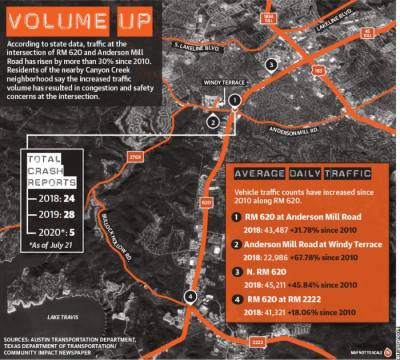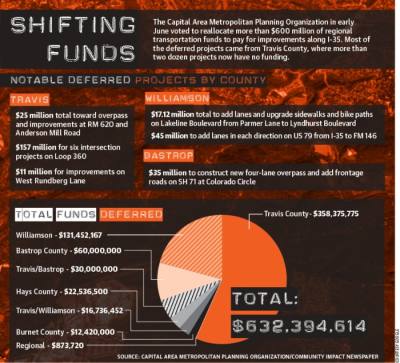One year later, that funding was shuffled to pay for monumental I-35 projects.
A June 8 vote from the Capital Area Metropolitan Planning Organization redirected $25 million earmarked for the intersection overpass project to the I-35 Capital Express Project. That $4.9 billion I-35 project will add dedicated, nontolled lanes through the city of Austin to alleviate congestion along one of the state’s most clogged highways.
But local leaders say the move has now left residents and businesses along RM 620 in Northwest Austin waiting on improvements of their own.
“The people who live along [RM] 620 are already facing some of the longest and most challenging traffic ... in our region,” said Jimmy Flannigan, who represents District 6 on Austin City Council.
State officials say the overpass at RM 620 and Anderson Mill is still on the table, but now that the project has lost funding, there are no major improvements ready to begin construction for the foreseeable future.
“It does need to be addressed and expanded,” said Tucker Ferguson, Austin district engineer for the Texas Department of Transportation. “No one says the need for developing that corridor is not there.”
Regional funding fallout
Regional planners began looking at redirecting funds from the RM 620 overpass project soon after the calendar page turned on the new decade.
In February, the Texas Transportation Commission secured $4.3 billion to foot the large majority of the estimated $4.9 billion bill for the I-35 Express project. The commission then tasked CAMPO with finding more than $600 million of regional projects to divert to help pay for the I-35 improvements.
On June 8, after months of workshops and open houses, CAMPO voted to ultimately defer a total $633 million of regional construction projects that had previously been earmarked for funding.
The RM 620 at Anderson Mill overpass project was one project of dozens defunded by that CAMPO vote. Split between two projects, the overpass and improvements at the intersection total an estimated $25 million, state documents show. As of today, there are no funds—federal, state or local—allocated to the project.
The earliest that TxDOT would have let the project out for bidding was 2024, Ferguson said. One of the reasons the overpass lost its funding, CAMPO Executive Director Ashby Johnson added, was that the project was not ready to begin construction.
“There was a heavy focus on project readiness. We didn’t want a bunch of money sitting around that wasn’t being used,” Johnson said.
In all, defunded projects in Travis and Williamson counties account for 77% of funding diverted by the CAMPO decision.
CAMPO delegates representing the city of Austin and Travis County were the only members of the board, which consists of voting members from the six-county Central Texas area, to vote against the reallocation of funds. Of the eight CAMPO members representing Austin and Travis County, six voted against the measure. Interim Travis County Judge Sam Biscoe and commissioner Gerald Daugherty were the only yes votes.
“Ultimately, I-35 is a regional road. It serves the region more than it serves the city of Austin,” said Flannigan, who voted against the measure. “It’s not about whether the I-35 project itself is good or bad, but ... I couldn’t support it where we were.”
Brigid Shea, Travis County commissioner for Precinct 2 and a member of the CAMPO policy board, voted against deferring funds. The commissioner said she cast her vote because of transparency issues, saying she received no justification for defunding the RM 620 overpass project.
“CAMPO was put in a difficult decision. Whose ox were they going to gore?” Shea said. “They just don’t have a good explanation for why they’ve made certain decisions.”
Proponents of the CAMPO vote advocate that the vote was a once-in-a-lifetime opportunity to secure funding for badly needed I-35 improvements.
According to a 2018 report from the Texas A&M Transportation Institute, the stretch of I-35 between US 290 in North Austin and Ben White Boulevard in South Austin is the third-most congested roadway in the state.
Cynthia Long, Williamson County commissioner for Precinct 2 and chair of the CAMPO Transportation Policy Board, said the region cannot afford to pass up the opportunity to secure billions of state funds for I-35.
“Not voting on it was not an option,” Long said. “For CAMPO to have not voted to defer projects would have meant that we would have been telling [TTC,] ‘No thank you, we don’t want $4 billion coming to Central Texas.’”
The trouble with traffic
Residents of Canyon Creek, a neighborhood adjacent to the intersection at RM 620 and Anderson Mill, have long dealt with congestion problems along RM 620. Randy Lawson, director of the Canyon Creek Homeowners’ Association, said the community has been advocating for improvements along the roadway for at least half a decade.
“The traffic in and around the intersection has gotten worse,” Lawson said. “It’s been bad for a long, long time, but no one has stepped up with the funding.”
Traffic at the intersection at RM 620 and Anderson Mill swelled by more than 30% from 2010-18, according to TxDOT data.
Use of the roadways leading up to the intersection have seen similar increases as well. The section of RM 620 1 mile north of the intersection saw a 45% increase in motorists during that same time period, and the number of motorists on Anderson Mill just west of the intersection rose 67%.
A 2017 TxDOT study of RM 620 gave F service grades to the intersection at Anderson Mill for congestion during morning and evening peak traffic. The only other intersection to receive the same grades in that study was the convergence of RM 620 and RM 2222 in the Four Points area.
That same TxDOT study found 305 crashes had been reported from Anderson Mill to SH 45 N along RM 620 from 2010-15.
“The folks who live along RM 620, it seems that everyone has a story or two about getting in a car accident,” Flannigan said.
Where does the project stand now?
TxDOT and CAMPO officials are quick to state the projects that have lost funding are not entirely scrapped. State officials will continue collecting public responses on the project as well as conduct environmental reviews, Ferguson said. The idea is to get the project as far along as possible in case any federal or state funding gets freed up.
“We would get our environmental clearances beginning in mid-2022. ... That sort of ties us down to where the alignment will be,” Ferguson said. “We still recognize [this project] as a priority.”
Other traffic solutions on the table right now could help thin traffic numbers along RM 620 by Anderson Mill Road, local officials say.
Shea said the rise in telecommuting, or working from home, is currently showing a reduction in congestion and wait times.
“It’s the cheapest, fastest and most effective way to solve all of our traffic congestion problems,” Shea said. The commissioner stated she believes local and state agencies can help reduce traffic numbers by asking eligible employees to work from home.•Flannigan said he is pushing city staff to install traffic signals with smarter technology along RM 620. Those signals, he said, will help keep a continuous flow of traffic along the arterial roadway.
“It’s not the magic solution to traffic, but it’s better than nothing,” Flannigan said.
For any large projects, however, state funding is likely necessary, Flannigan said. The intersection at RM 620 and Anderson Mill also happens to be the conjunction of four jurisdictions—Austin, Cedar Park and Travis and Williamson counties.
“It is a very complicated [project] to solve without state support,” Flannigan said.
Note from the editor: This article has been updated to correct the spelling of the name of Randy Lawson, director of the Canyon Creek Homeowners’ Association.







